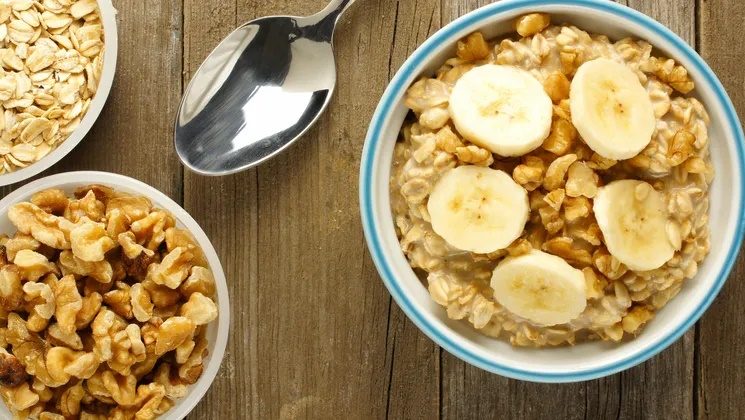Magnesium in food: Where is it most?
Cramps, fatigue or headaches can be symptoms of magnesium deficiency. / Magnesium in food: Where is it most?

The symptoms can be alleviated with the right diet. / Magnesium in food: Where is it most?
Magnesium: why is it so important for the body?
Magnesium is required for a variety of bodily functions. The body stores around 60 percent in the bones, 29 percent in the muscles and one percent circulates in the blood. Accordingly, magnesium is needed above all for healthy bone structure, healthy teeth and strong muscles. It also plays a major role in energy metabolism and the nervous system.
A magnesium deficiency is usually noticeable through muscle cramps and tension. Tiredness, concentration and digestive disorders, headaches and circulatory problems are also possible. In order to prevent such complaints, you should consume sufficient magnesium. The daily requirement for women is around 350 milligrams, for men up to 400 milligrams a day. Pregnant women, breastfeeding women, diabetics and athletes have an increased need for magnesium.
Because the body cannot produce the mineral on its own, magnesium must be supplied through food or appropriate dietary supplements. As a rule, a magnesium-rich diet is sufficient to cover the requirement and to counteract a magnesium deficiency.
What to eat if you are deficient in magnesium These foods are particularly rich in magnesium
1. seeds / Magnesium in food
Seeds are one of the most valuable sources of magnesium. Hemp seeds in particular are real magnesium bombs: 100 grams contain up to 700 mg of the mineral. With three tablespoons of hemp seeds, you have already covered almost 50 percent of your daily magnesium requirement. In addition, the superfood contains a lot of protein and omega-3 fatty acids. Also rich in magnesium are:
pumpkin seeds
sunflower seeds
linseed
Chia seeds
sesame
Poppy
2. Nuts
One of the most valuable sources of magnesium are nuts. Walnuts are particularly valuable for the organism: They not only provide a lot of magnesium, but also folic acid, vitamins B and E, zinc and potassium. In addition, they contain no cholesterol, but the important omega-3 fatty acids. The variety of nuts is great:
brazil nuts
hazelnuts
cashew nuts
almonds
pine nuts
peanuts
pecans
Caution: Nuts are very high in fat and calories and should therefore only be eaten in moderation. The German Society for Nutrition (DGE) recommends a handful per day (approx. 25 g) – this already covers around a quarter of your daily magnesium requirement.
3. Cocoa
In addition to nuts and seeds, cocoa is another source of magnesium. Anyone suffering from a magnesium deficiency should use dark, bittersweet chocolate with a cocoa content of at least 70-85 percent. Because the darker the chocolate, the higher the magnesium content. You should therefore also prefer pure cocoa powder for the preparation of drinks, cakes and desserts.
4. Legumes / Magnesium in food
Legumes are also very rich in magnesium and contain between 100 and 200 mg per 100 grams. These include:
Peas
Chickpeas
White beans
Mung beans
kidney beans
soybeans
lenses
lupins
5. Grain
Foods such as whole grain rice, whole grain bread and whole grain pasta provide a lot of magnesium. Many valuable nutrients are found in the outer shell of cereals and rice. If this is removed, magnesium is automatically removed from the food. Therefore, reach for the whole grain variant or, for rice, for unpeeled brown rice.
Wheat bran, wheat germ and rolled oats are also good sources of magnesium and are ideal for preparing muesli, smoothies or bread.
So-called pseudo-grains, such as amaranth, buckwheat and quinoa, are very similar to real grains in appearance, taste and use, but belong to different plant families. They are also rich in magnesium and a healthy and gluten-free alternative to rice and co.
6. Fruit
In particular, berries such as blackberries and raspberries (30 mg), bananas (36 mg), kiwis (17 mg) and pineapple (12 mg) are good sources of magnesium.
7. Vegetables
If you like eating vegetables, you should eat more green vegetables if you have a magnesium deficiency. Note, however, that the magnesium content of vegetables can decrease depending on how they are prepared. The following vegetables contain the most magnesium:
Spinach
artichokes
Kale
broccoli
potatoes
fennel
8. Fish / Magnesium in food
Fish not only contains healthy omega-3 fatty acids, but also magnesium. The types of fish with the highest magnesium content are:
sole
turbot
herring
carp
Salmon
Trout
Attention: With all the tips regarding solid foods, you must not forget one thing: drink a lot! Mineral water is also one of the best sources of magnesium. Some mineral waters are even enriched with magnesium.
Table: These are the foods with the highest magnesium content
The following list shows the foods with the highest magnesium content. Vegetarians and vegans can rejoice: None of the food is of animal origin.
Food Magnesium Content (mg/100g)
Hemp seeds 600-700
Pumpkin seeds 535
Wheat Bran 495
Sunflower seeds 420
Cocoa 420
Brazil nuts 376
Flaxseed 350
Amaranth 330
Sesame 330
poppy 330
pine nuts 330
Dark chocolate 290
cashew nuts 290
Soybeans 280
Quinoa 275
Buckwheat 230
Almonds 220
peanuts 180
Millet 170
Rice 157
Hazelnuts 155
Wholemeal bread 150
Oatmeal 140
Kidney beans 140
walnuts 131
Diet tips for magnesium deficiency: How to cover your magnesium needs
For breakfast, prepare a granola made from rolled oats, wheat bran, amaranth, and assorted seeds and nuts. Combine milk, yoghurt and fresh fruit, such as bananas and berries, as you like. If you prefer something savory, a whole grain bread with cheese is a magnesium-rich choice.
When it comes to pasta, rice and bread, go for the whole grain variety. A gluten-free and magnesium-rich side dish alternative is quinoa.
Stew or steam vegetables instead of cooking them. In this way, most of the minerals are retained.
When baking, use poppy seeds or real cocoa. It can be used to make delicious cakes and desserts.
When it comes to chocolate, go for the dark variant. If nuts are also included, the magnesium content is even higher.
Sprinkle some sunflower seeds or pumpkin seeds over your salad.
Nuts or dried bananas are a healthy and magnesium-rich snack in between meals.
Drink enough fluids, preferably mineral water.
The magnesium content of food can be influenced by the way it is prepared. When roasting meat, for example, 20 to 30 percent of the mineral is lost. When cooking vegetables such as spinach or broccoli, the losses are 25 to 40 percent. Therefore, make sure you prepare the food carefully. When stewing and steaming, the vegetables only come into contact with a small amount of water so that the water-soluble ingredients, such as minerals and vitamins, are not washed out.
The mineral content in food is also falling continuously due to changes in agriculture, over-fertilization and industrial processing. Therefore, the magnesium content for a food can also vary depending on the brand and manufacturer. It is controversial whether foods from organic farming contain more magnesium than those from conventional farming.


